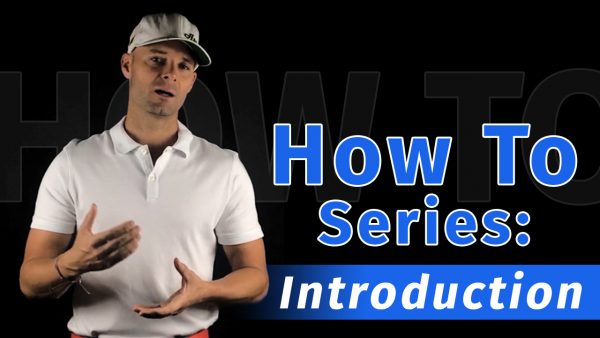How-to Series: How to move your hips on the backswing
This is the first installment in our How To Series — follow this plan to master the movements of the hips on the backswing!

Watch the series introduction here
This new series is all about helping you improve your golf swing quickly. We’re going to break the swing down into its component parts and give you specific practice direction — master these key elements of the swing and you’ll see improvement fast!
Instruction
The Wedge Guy: Beating the yips into submission

There may be no more painful affliction in golf than the “yips” – those uncontrollable and maddening little nervous twitches that prevent you from making a decent stroke on short putts. If you’ve never had them, consider yourself very fortunate (or possibly just very young). But I can assure you that when your most treacherous and feared golf shot is not the 195 yard approach over water with a quartering headwind…not the extra tight fairway with water left and sand right…not the soft bunker shot to a downhill pin with water on the other side…No, when your most feared shot is the remaining 2- 4-foot putt after hitting a great approach, recovery or lag putt, it makes the game almost painful.
And I’ve been fighting the yips (again) for a while now. It’s a recurring nightmare that has haunted me most of my adult life. I even had the yips when I was in my 20s, but I’ve beat them into submission off and on most of my adult life. But just recently, that nasty virus came to life once again. My lag putting has been very good, but when I get over one of those “you should make this” length putts, the entire nervous system seems to go haywire. I make great practice strokes, and then the most pitiful short-stroke or jab at the ball you can imagine. Sheesh.
But I’m a traditionalist, and do not look toward the long putter, belly putter, cross-hand, claw or other variation as the solution. My approach is to beat those damn yips into submission some other way. Here’s what I’m doing that is working pretty well, and I offer it to all of you who might have a similar affliction on the greens.
When you are over a short putt, forget the practice strokes…you want your natural eye-hand coordination to be unhindered by mechanics. Address your putt and take a good look at the hole, and back to the putter to ensure good alignment. Lighten your right hand grip on the putter and make sure that only the fingertips are in contact with the grip, to prevent you from getting to tight.
Then, take a long, long look at the hole to fill your entire mind and senses with the target. When you bring your head/eyes back to the ball, try to make a smooth, immediate move right into your backstroke — not even a second pause — and then let your hands and putter track right back together right back to where you were looking — the HOLE! Seeing the putter make contact with the ball, preferably even the forward edge of the ball – the side near the hole.
For me, this is working, but I am asking all of you to chime in with your own “home remedies” for the most aggravating and senseless of all golf maladies. It never hurts to have more to fall back on!
Instruction
Looking for a good golf instructor? Use this checklist

Over the last couple of decades, golf has become much more science-based. We measure swing speed, smash factor, angle of attack, strokes gained, and many other metrics that can really help golfers improve. But I often wonder if the advancement of golf’s “hard” sciences comes at the expense of the “soft” sciences.
Take, for example, golf instruction. Good golf instruction requires understanding swing mechanics and ball flight. But let’s take that as a given for PGA instructors. The other factors that make an instructor effective can be evaluated by social science, rather than launch monitors.
If you are a recreational golfer looking for a golf instructor, here are my top three points to consider.
1. Cultural mindset
What is “cultural mindset? To social scientists, it means whether a culture of genius or a culture of learning exists. In a golf instruction context, that may mean whether the teacher communicates a message that golf ability is something innate (you either have it or you don’t), or whether golf ability is something that can be learned. You want the latter!
It may sound obvious to suggest that you find a golf instructor who thinks you can improve, but my research suggests that it isn’t a given. In a large sample study of golf instructors, I found that when it came to recreational golfers, there was a wide range of belief systems. Some instructors strongly believed recreational golfers could improve through lessons. while others strongly believed they could not. And those beliefs manifested in the instructor’s feedback given to a student and the culture created for players.
2. Coping and self-modeling can beat role-modeling
Swing analysis technology is often preloaded with swings of PGA and LPGA Tour players. The swings of elite players are intended to be used for comparative purposes with golfers taking lessons. What social science tells us is that for novice and non-expert golfers, comparing swings to tour professionals can have the opposite effect of that intended. If you fit into the novice or non-expert category of golfer, you will learn more and be more motivated to change if you see yourself making a ‘better’ swing (self-modeling) or seeing your swing compared to a similar other (a coping model). Stay away from instructors who want to compare your swing with that of a tour player.
3. Learning theory basics
It is not a sexy selling point, but learning is a process, and that process is incremental – particularly for recreational adult players. Social science helps us understand this element of golf instruction. A good instructor will take learning slowly. He or she will give you just about enough information that challenges you, but is still manageable. The artful instructor will take time to decide what that one or two learning points are before jumping in to make full-scale swing changes. If the instructor moves too fast, you will probably leave the lesson with an arm’s length of swing thoughts and not really know which to focus on.
As an instructor, I develop a priority list of changes I want to make in a player’s technique. We then patiently and gradually work through that list. Beware of instructors who give you more than you can chew.
So if you are in the market for golf instruction, I encourage you to look beyond the X’s and O’s to find the right match!
Instruction
What Lottie Woad’s stunning debut win teaches every golfer

Most pros take months, even years, to win their first tournament. Lottie Woad needed exactly four days.
The 21-year-old from Surrey shot 21-under 267 at Dundonald Links to win the ISPS Handa Women’s Scottish Open by three shots — in her very first event as a professional. She’s only the third player in LPGA history to accomplish this feat, joining Rose Zhang (2023) and Beverly Hanson (1951).
But here’s what caught my attention as a coach: Woad didn’t win through miraculous putting or bombing 300-yard drives. She won through relentless precision and unshakeable composure. After watching her performance unfold, I’m convinced every golfer — from weekend warriors to scratch players — can steal pages from her playbook.
Precision Beats Power (And It’s Not Even Close)
Forget the driving contests. Woad proved that finding greens matters more than finding distance.
What Woad did:
• Hit it straight, hit it solid, give yourself chances
• Aimed for the fat parts of greens instead of chasing pins
• Let her putting do the talking after hitting safe targets
• As she said, “Everyone was chasing me today, and managed to maintain the lead and played really nicely down the stretch and hit a lot of good shots”
Why most golfers mess this up:
• They see a pin tucked behind a bunker and grab one more club to “go right at it”
• Distance becomes more important than accuracy
• They try to be heroic instead of smart
ACTION ITEM: For your next 10 rounds, aim for the center of every green regardless of pin position. Track your greens in regulation and watch your scores drop before your swing changes.
The Putter That Stayed Cool Under Fire
Woad started the final round two shots clear and immediately applied pressure with birdies at the 2nd and 3rd holes. When South Korea’s Hyo Joo Kim mounted a charge and reached 20-under with a birdie at the 14th, Woad didn’t panic.
How she responded to pressure:
• Fired back with consecutive birdies at the 13th and 14th
• Watched Kim stumble with back-to-back bogeys
• Capped it with her fifth birdie of the day at the par-5 18th
• Stayed patient when others pressed, pressed when others cracked
What amateurs do wrong:
• Get conservative when they should be aggressive
• Try to force magic when steady play would win
• Panic when someone else makes a move
ACTION ITEM: Practice your 3-6 foot putts for 15 minutes after every range session. Woad’s putting wasn’t spectacular—it was reliable. Make the putts you should make.
Course Management 101: Play Your Game, Not the Course’s Game
Woad admitted she couldn’t see many scoreboards during the final round, but it didn’t matter. She stuck to her game plan regardless of what others were doing.
Her mental approach:
• Focused on her process, not the competition
• Drew on past pressure situations (Augusta National Women’s Amateur win)
• As she said, “That was the biggest tournament I played in at the time and was kind of my big win. So definitely felt the pressure of it more there, and I felt like all those experiences helped me with this”
Her physical execution:
• 270-yard drives (nothing flashy)
• Methodical iron play
• Steady putting
• Everything effective, nothing spectacular
ACTION ITEM: Create a yardage book for your home course. Know your distances to every pin, every hazard, every landing area. Stick to your plan no matter what your playing partners are doing.
Mental Toughness Isn’t Born, It’s Built
The most impressive part of Woad’s win? She genuinely didn’t expect it: “I definitely wasn’t expecting to win my first event as a pro, but I knew I was playing well, and I was hoping to contend.”
Her winning mindset:
• Didn’t put winning pressure on herself
• Focused on playing well and contending
• Made winning a byproduct of a good process
• Built confidence through recent experiences:
- Won the Women’s Irish Open as an amateur
- Missed a playoff by one shot at the Evian Championship
- Each experience prepared her for the next
What this means for you:
• Stop trying to shoot career rounds every time you tee up
• Focus on executing your pre-shot routine
• Commit to every shot
• Stay present in the moment
ACTION ITEM: Before each round, set process goals instead of score goals. Example: “I will take three practice swings before every shot” or “I will pick a specific target for every shot.” Let your score be the result, not the focus.
The Real Lesson
Woad collected $300,000 for her first professional victory, but the real prize was proving that fundamentals still work at golf’s highest level. She didn’t reinvent the game — she simply executed the basics better than everyone else that week.
The fundamentals that won:
• Hit more fairways
• Find more greens
• Make the putts you should make
• Stay patient under pressure
That’s something every golfer can do, regardless of handicap. Lottie Woad just showed us it’s still the winning formula.
FINAL ACTION ITEM: Pick one of the four action items above and commit to it for the next month. Master one fundamental before moving to the next. That’s how champions are built.
PGA Professional Brendon Elliott is an award-winning coach and golf writer. You can check out his writing work and learn more about him by visiting BEAGOLFER.golf and OneMoreRollGolf.com. Also, check out “The Starter” on RG.org each Monday.
Editor’s note: Brendon shares his nearly 30 years of experience in the game with GolfWRX readers through his ongoing tip series. He looks forward to providing valuable insights and advice to help golfers improve their game. Stay tuned for more Tips!




















Ron Burgundy
Jan 26, 2020 at 12:59 am
Had anyone bought this? Is it any good?
geohogan
Dec 23, 2018 at 9:47 pm
@raybennett, if only it were true.
Bobby Jones turned his torso (from hips to sternum turning together), using his feet and knees. There is no sway to the right.
This video describes left hip moving closer to the ball. ie not a turn of the torso
but a slide of hips back toward the right, which can only happen when shoulders tilt , left shoulder down. Its the False backswing made popular with the one plane swing, that ended the career of Mike Weir and others.
Its easily proven. Stand straight and tilt the left shoulder down toward the ball. Note how right hip moves(sways to the right) and pelvis slides= FALSE BS TURN
Compare that to standing straight and turning to shake hands with someone to your right, with your left hand. Rather than right hip moving laterally to the right, it moves toward the left.
Kenny
Dec 21, 2018 at 11:29 pm
Trying to link movements of body parts together to try and make a swing is absurd.
Don Toth
Dec 18, 2018 at 8:40 pm
Really like Session 1 it’s a clear and simple plan for a start. Many students can get so far off track early in the swing motion. This give them a very clear plan to feel and execute right at the start of the movement.
Very Nice!!
Golf
Dec 18, 2018 at 8:18 am
I typically like Lucas but this is rubbish. Keep it simple and focus more on impact not the takeaway like Adam Young does. Better results, faster and simpler.
geohogan
Dec 17, 2018 at 11:17 pm
x Factor might be valid if shoulder joints were simply blobs on the top end of the spine.
The function of the scapula and clavicle allow a very free range of movement about the top of the torso.
That range of motion has lead some to think that X factor means restricting hip turn… they would be wrong, leading to spine issues for countless golfers.
Ray Bennett
Dec 17, 2018 at 4:48 pm
Spot on advice. This is exactly what Bobby Jones did to start his backswing which he described in his publication Bobby Jones on Golf. It is great to see the old school instruction returning to the game.
smz
Dec 17, 2018 at 5:50 pm
… but it only applies to swings with a whippy hickory shafted club…!
geo
Dec 17, 2018 at 9:14 pm
http://www.golfwrx.com/forums/topic/553341-hickory-golf-clubs-shafts/
“hickory shafts generally run at stiffer frequencies than the steel shafts of the same
“flex”. Bobby Jones hickory shafts would rate X flex with very low torque, by todays
definition “
geohogan
Dec 23, 2018 at 12:32 pm
@raybennett, if only it were true.
Bobby Jones turned his torso (from hips to sternum turning together), using his feet and knees. There is no sway to the right.
This video describes left hip moving closer to the ball. ie not a turn of the torso
but a slide of hips back toward the right, which can only happen when shoulders tilt , left shoulder down. Its the False backswing made popular with the one plane swing, that ended the career of Mike Weir and others.
Its easily proven. Stand straight and tilt the left shoulder down toward the ball. Note how right hip moves(sways to the right) and pelvis slides= FALSE BS TURN
Compare that to standing straight and turning to shake hands with someone to your right, with your left hand. Rather than right hip moving laterally to the right, it moves toward the left.
Raymond CHASTEL
Dec 17, 2018 at 12:42 pm
Dear Mr Wald ,Nice and thorough presentation ,but I beg to differ:my right instep is firmly dug in the turf:then I start by pushing my left shoulder forward :I don’t move back as you show:my hips stay as straight as possible while the shoulders turn fully ,to create the differential HIPS-SHOULDERS (The X Factor ).The purpose is to coil the core to provide the maximum spring effect giving power.
I’m 84 ,average build,5fet 9 ,160 pounds ,I play three /four times a week to a 7 Handicap on the FRENCH RIVERA ,all year round ,no winter,no winter greens over here
gaspard
Dec 17, 2018 at 5:48 pm
… and you drink beaujolais spritzers on your fremch golf course for nourishment and to combat thirst…. 😮
Wyatt
Dec 17, 2018 at 12:07 pm
Too many moving parts for me. When I take my setup, I make sure my left hip is slightly elevated and then I make my normal inside to out swing. The hips make a normal turn when doing that.
Gary Slatter PGA
Dec 17, 2018 at 12:02 pm
1 and 2 were OK, I disagree with consciously turning your hips. They turn in response to your knees and shoulder turn, in my opinion.
smz
Dec 17, 2018 at 5:52 pm
…. and for some it’s the m a s s of the a s s according to Snead with his backswing squat that he carries into his downswing…..!
Jim
Dec 18, 2018 at 10:05 pm
No, turning shoulder pulls your ribs & torso. Does NOT necessarily make the hip turn. Bigger muscular golfers must make a coordinated hip turn to achieve the most they can get – and thin flexible people can get 100° of turn and not even notice they barely turned 25 degrees with their hips.
MDH
Dec 17, 2018 at 11:29 am
I think you should demonstrate the hip turn showing it from the front and back view.
smz
Dec 16, 2018 at 1:40 pm
WARNING: If your pot belly covers your belt buckle do not, I repeat, do not rotate your hips because that will twist your spine and your hanging pot belly will overstress your spine and cause lower back pain. Even a smaller protruding gut will hurt your spine sfter too many practice swings. You have been warned.
geohogan
Dec 17, 2018 at 9:09 am
HIps dont rotate. The knees move the hips.
Prove it to yourself by tying a belt around your thighs above the knees so knees cant move.
Now try turning your hips.
Golf instruction that doesnt involve the knees leading the hips, is advocating shoulder tilt and hip slide…. a fake turn.
smz
Dec 17, 2018 at 5:45 pm
Okay, matey…. it’s the legs first that move the hips in a rotatory motion. Happy?
geohogan
Dec 17, 2018 at 8:44 pm
@smz, the legs move the torso. Hips happen to go along for the ride.
Gary “The Swings the Thing” Slatter PGA knows.
smz
Dec 17, 2018 at 10:38 pm
torso –the trunk of the human body without, or considered independently of, the head and limbs.
Hips are part of the torso… and the semi-flexible core separates the shoulders from the hips… called the X-Factor.
geohogan
Dec 17, 2018 at 11:14 pm
x Factor might be valid if shoulder joints were simply blobs on the top end of the spine.
The function of the scapula and clavicle allow a very free range of movement about the top of the torso.
That range of motion has lead some to think that X factor means restricting hip turn… they would be wrong, leading to spine issues for countless golfers.
Kenny
Dec 21, 2018 at 11:35 pm
X factor is nonsense.
geohogan
Dec 18, 2018 at 3:14 pm
http://www.oandplibrary.org/reference/uclamanual/UCLA-02.pdf
When we use the full range of motion of the scapula and shoulder joint
combined with turning of the torso 40-50 degrees, the so called X factor is easily
achieved with sternum consistently aligned with the sagittal plane.
ie little or no twisting of the spine.
geo
Dec 18, 2018 at 3:37 pm
http://www.oandplibrary.org/reference/uclamanual/UCLA-02.pdf
The torso can be turned 40=50 degrees by the legs, knees and feet.
The balance of BS, can be made by the shoulder joint and scapula without twisting the spine.
ref. ROM above
If the so called X factor is achieved by turning the upper torso more than the lower torso, injury to the spine will result.
Kenny
Dec 21, 2018 at 11:33 pm
Correct in that the hips don’t rotate independently, but the knees don’t move the hips. All motion stems from the feet. Sequence of motion in the joints is feet, ankles, knees, pelvis.
geohogan
Dec 23, 2018 at 12:16 pm
@kenny, agree totally, the hips dont rotate independently.(Hips have no means to move independently of lower limbs.)
Suggest that sequence is feet, ankles, knees, torso(hips are moved with the torso).
Once we understand this simply basic of human physiology, we must understand how foolish it is to think that we can possibly , “fire the hips”.
Bert Gwaltney
Dec 15, 2018 at 9:25 am
OK, found the first segment. Thanks
Bert Gwaltney
Dec 15, 2018 at 9:16 am
Introductions are OK, but should have included the first segment. I lost interest quickly.